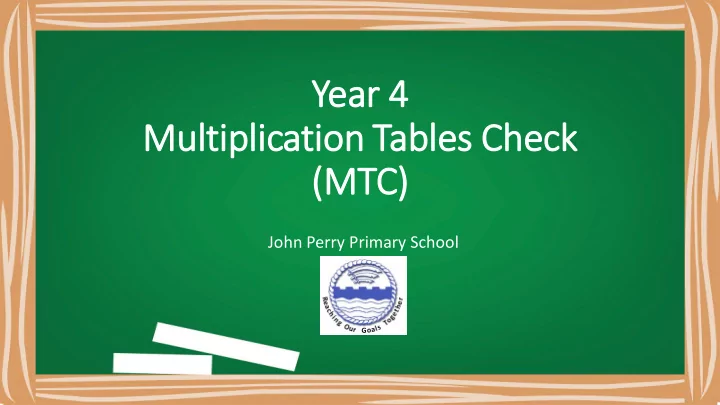

Year 4 Multiplication Tables Check (M (MTC) John Perry Primary School
Mul ultip ipli licatio ion Table les Che heck overv erview • The purpose of the Multiplication Tables Check (MTC) is to determine whether year 4 pupils can fluently recall their multiplication tables • All eligible year 4 pupils who are registered at maintained schools, special schools or academies (including free schools) in England will be required to take the check • It will be statutory from the 2019/20 academic year • There will be a 3-week window in June for the administration of the check. There is no set test day, nor an expectation that all children will take the check at the same time Google “Multiplication Tables Check Assessment Framework” to access the whole document
Wha hat do does it it consis ist t of? of? • Year 4 children will only face multiplication statements in the check. Related division facts, whilst a key part of children’s mathematical learning, will not be tested as part of the check • The test will be fully digital and take place on screen. It will be available to use on laptops, desktops and tablets • There will be 25 questions with 6 seconds to answer and with a 3 second gap between questions. It will take less than 5 minutes per pupil • Children can input the answers tapping on the number pad. Alternatively, they can use the mouse to click on the number pad or insert the answer using the keyboard (if using a desktop)
Wha hat exac actly ly will ill be be tes ested? There will not be an equal spread of each multiplication table within the check • The check has been designed to focus on times tables that fit within the KS2 curriculum • The 6, 7, 8, 9 and 12 times tables are more likely to be asked than the 2, 3, 4, 5, 10 or 11 multiplication tables. The STA state that there is a focus on these as these are the ‘most difficult’ multiplication tables • There will always be questions from the 3, 4, 5, 6, 7, 8, 9, 11 and 12 multiplication tables in each test • There will be no questions from the 1 times table (i.e 1 x 8 or 8 x 1) • There will only be a maximum of 7 questions from the 2, 5 and 10 times tables • Reversal of questions using the commutative law will not feature in the same check. This means that, for example, 8 x 3 and 3 x 8 won’t be asked to the same pupil
Who can an be be wit ithdrawn fr from om the the tes est? t? The grounds for withdrawal are very strict. Pupils should not take the check if any of the following apply: • they are absent during the entire 3-week check period • they are unable to access the check, even when using access arrangements • they are working below expectation for year 2 in multiplication tables and are considered unable to answer the easiest questions • they have just arrived in school during the check window, with EAL, and there is not enough time to establish the standard at which they are working • they have been incorrectly registered for the check • they have left the school before the check period
Wha hat abo about res esult lts? • The child (or teacher) will not be shown the total score on screen • There is no expected pass rate or threshold. Children will not be expected to re- sit the check if they do not meet a set threshold (if there is one) • Results will be notified to parents • Results will not be published in school performance tables
Why is is it it so so contr trover ersial? l? • The check will be really challenging . It requires maximum concentration and tables really do need to be known ‘off by heart’ • The expected score is 25 out of 25 and time is extremely limited. Errors will be almost impossible to correct within the 6 second time limit. Using a touch screen seems to be the quickest way of answering • There are no rewards or clues as to how well you are doing as you go along and if children do not know their times tables it can be quite demoralising
Let’s try it!
How ar are e we e getti ting you our chil children rea eady for or it? it? • By building in time to teach and practise times tables (out of sequence) at least three times a week • By familiarising the children with the style of the test so nothing is ‘new’ when they take the actual check
How can an you ou he help lp you our ch chil ild at t ho home? Please see printout.
Any qu questio ions?
Recommend
More recommend